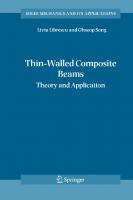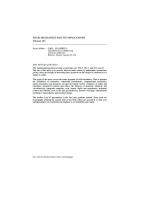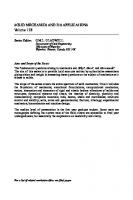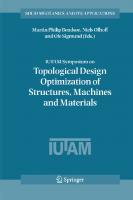The Behavior of Structures Composed of Composite Materials (Solid Mechanics and Its Applications, 105) 1402009046, 9781402009044
143 87 27MB
English Pages [457]
Recommend Papers

- Author / Uploaded
- Jack R. Vinson
- Robert L. Sierakowski
File loading please wait...
Citation preview
The Behavior of Structures Composed of Composite Materials
SOLID MECHANICS AND ITS APPLICATIONS Volume 105 Series Editor: G.M.L. GLADWELL Department of Civil Engineering University of Waterloo Waterloo, Ontario, Canada N2L 3GI
Aims and Scope of the Series The fundamental questions arising in mechanics are: Why?, How?, and How much? The aim of this series is to provide lucid accounts written by authoritative researchers giving vision and insight in answering these questions on the subject of mechanics as it relates to solids. The scope of the series covers the entire spectrum of solid mechanics. Thus it includes the foundation of mechanics; variational formulations; computational mechanics; statics, kinematics and dynamics of rigid and elastic bodies: vibrations of solids and structures; dynamical systems and chaos; the theories of elasticity, plasticity and viscoelasticity; composite materials; rods, beams, shells and membranes; structural control and stability; soils, rocks and geomechanics; fracture; tribology; experimental mechanics; biomechanics and machine design. The median level of presentation is the first year graduate student. Some texts are monographs defining the current state of the field; others are accessible to final year undergraduates; but essentially the emphasis is on readability and clarity.
For a list of related mechanics titles, see final pages.
The Behavior of Structures Composed of Composite Materials Second Edition
by
JACK R. VINSON H.Fletcher Brown Professor of Mechanical & Aerospace Engineering, The Center for Composite Materials and The College of Marine Studies, Department of Mechanical Engineering, University of Delaware, Newark, Delaware, U.S.A. and
ROBERT L. SIERAKOWSKI Chief Scientist, AFRL/MN Eglin AFB, Florida, U.S.A.
Library of Congress Control Number: 2008921377
ISBN 978-1-4020-0904-4 ISBN 978-0-306-48414-8 (e-book)
Published by Springer, P.O. Box 17, 3300 AA Dordrecht, The Netherlands. www.springer.com
Printed on acid-free paper
First print 2002 Reprinted 2008
All Rights Reserved © 2008 Springer Science+Business Media B.V. No part of this work may be reproduced, stored in a retrieval system, or transmitted in any form or by any means, electronic, mechanical, photocopying, microfilming, recording or otherwise, without written permission from the Publisher, with the exception of any material supplied specifically for the purpose of being entered and executed on a computer system, for exclusive use by the purchaser of the work.
Since the introduction of the second printing, a number of exciting advances has taken place within the materials community. Historically, we have accepted the inherent properties of materials as given for any specified material; that is, metals, polymers, ceramics and so on. Introduction of composite materials technology has allowed researchers to consider multi-constituent systems resulting in properties that can be superior to each of the constituents independently. Now we are on the cusp of a new era in materials technology which can be coined as the engineered materials revolution. That is, we are now developing the capacity to tailor a material to perform a specific or representative set of functions from the basic atomic level. This technical development allows for the potential design of microsystems with nano-components. The advent of this technology offers a number of creative future applications in advancing miniaturized systems including structural nano-electronic devices, circuits, and computers as but a few examples. These advances are based upon the extraordinary properties of carbon nanotubes including a Young’s modulus approaching that of diamond. These properties are ideal for reinforced composites, and this third edition provides the student or researcher with the necessary tools to advance the state of the art in structural design of new and potentially exciting multifunctional, self-repairing, self-duplicating, nano-structural materials.





![Advances in Engineering Structures, Mechanics & Construction: Proceedings of an International Conference on Advances in Engineering Structures, ... (Solid Mechanics and Its Applications, 140) [2006 ed.]
1402048904, 9781402048906](https://ebin.pub/img/200x200/advances-in-engineering-structures-mechanics-amp-construction-proceedings-of-an-international-conference-on-advances-in-engineering-structures-solid-mechanics-and-its-applications-140-2006nbsped-1402048904-9781402048906.jpg)
![Engineering Mechanics of Composite Materials [2nd ed.]
9780195150971](https://ebin.pub/img/200x200/engineering-mechanics-of-composite-materials-2ndnbsped-9780195150971.jpg)
![Mechanics of Composite Materials [2nd ed]
156032712X, 9781560327127](https://ebin.pub/img/200x200/mechanics-of-composite-materials-2nd-ed-156032712x-9781560327127.jpg)

![Tribological Applications of Composite Materials [1st ed.]
9789811596346, 9789811596353](https://ebin.pub/img/200x200/tribological-applications-of-composite-materials-1st-ed-9789811596346-9789811596353.jpg)